Device and method for detecting cardiac impairments
a medical device and cardiac impairment technology, applied in the field of medical devices and methods for processing cardiac signals, can solve the problems of difficult to assess, difficult to identify arrhythmia conditions, difficult to isolate small irregular oscillatory signals, etc., and achieve the effect of efficient and likely signal separation process
- Summary
- Abstract
- Description
- Claims
- Application Information
AI Technical Summary
Benefits of technology
Problems solved by technology
Method used
Image
Examples
Embodiment Construction
[0033]Embodiments of the invention relate to a system and method for accurately separating medical signals in order to determine disease states in a patient. In one embodiment, the system analyzes ECG signals in order to determine whether a patient has a heart ailment or irregularity. As discussed in detail below, embodiments of the system utilize the techniques of independent component analysis to separate the medical signals from one another.
[0034]In addition to the signal separation technique, embodiments of the invention also relate to systems and methods that first identify, attenuate, remove, isolate or suppress extraneous signals. Such extraneous signals can be signals derived from baseline drift, power line or other electrical and magnetic interference, motion artifacts, instrumentation noise generated by external sources, electrode contact noise, or interferences from other physiological sources, for example. Other physiological sources can include breathing, movement, or o...
PUM
 Login to View More
Login to View More Abstract
Description
Claims
Application Information
 Login to View More
Login to View More - R&D
- Intellectual Property
- Life Sciences
- Materials
- Tech Scout
- Unparalleled Data Quality
- Higher Quality Content
- 60% Fewer Hallucinations
Browse by: Latest US Patents, China's latest patents, Technical Efficacy Thesaurus, Application Domain, Technology Topic, Popular Technical Reports.
© 2025 PatSnap. All rights reserved.Legal|Privacy policy|Modern Slavery Act Transparency Statement|Sitemap|About US| Contact US: help@patsnap.com



